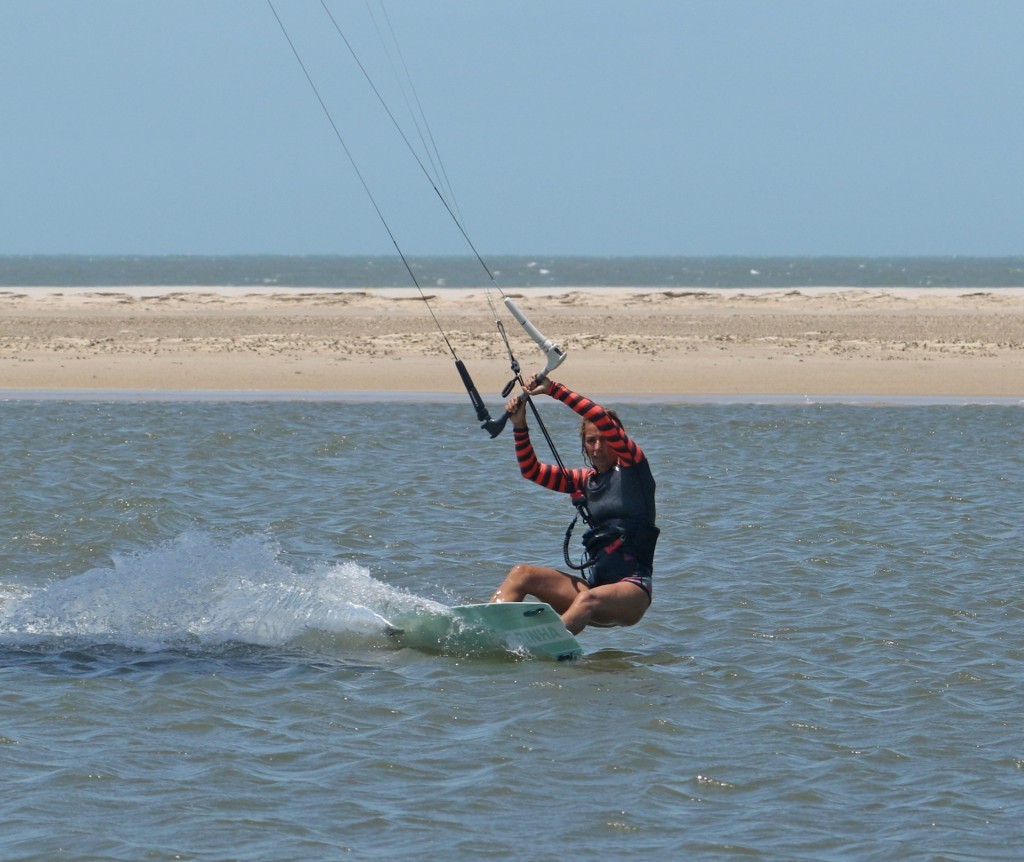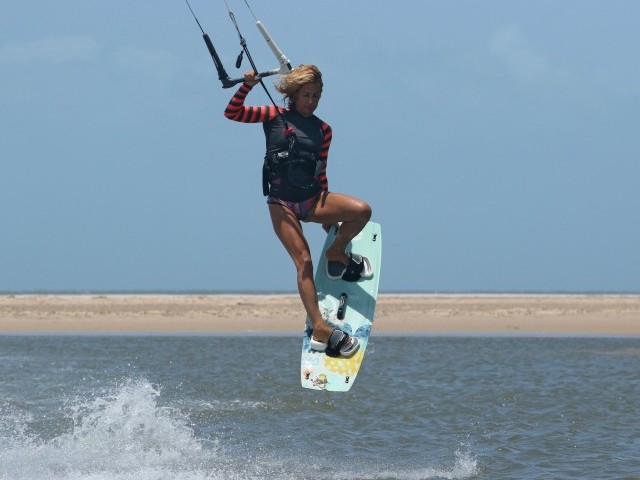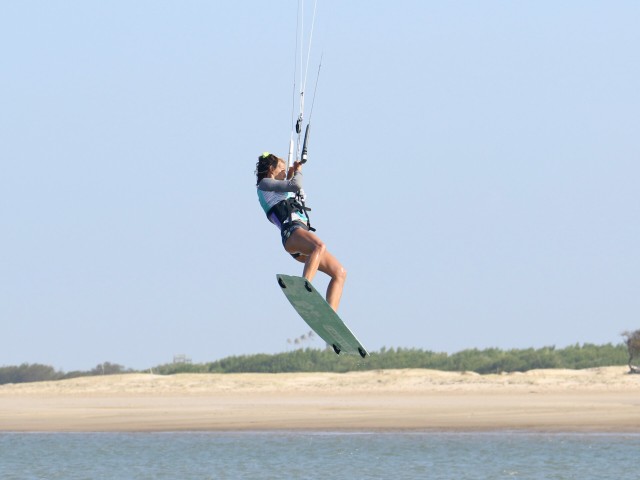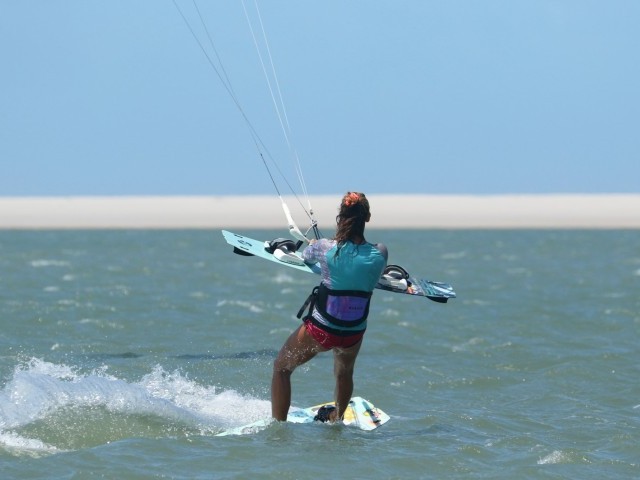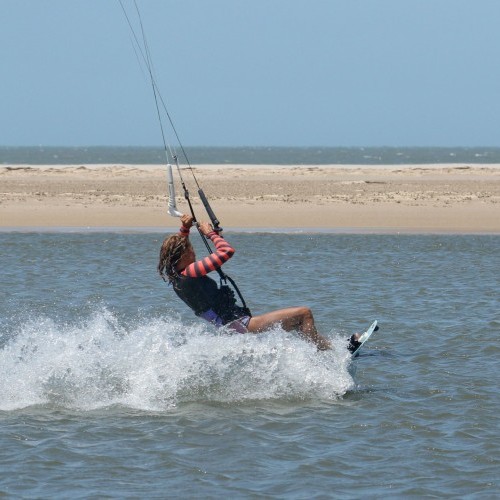
Twin Tip Upwind 360
Technique / Beginner
The last move of 2024! This is a classic strapless move, favourably adopted by the foiling community, and has a place in every twin tipper box of tricks. Moreover, if you’ve nailed the twin-tip duck tack, the carving upwind 360 is the flowing follow-up you never realised you needed. Still, you so do:) You’ll use the skills you already have from the duck tack to get yourself up and through the wind, and you’ll also need to call on your down loop transition from our learning to loop series, as it’s the only way to come out of this beauty and carry on as if nothing happened!
Let’s crack on. The first three moments that we’ll look at are the same as for the duck tack, so you should be happy with these! However, we will go through them again as a little refresher.
Approach Pic A
First off, check that you have plenty of space. You’ll loop the kite to come out of this, so you need lots of room.
Your approach needs speed, as you have a long way to go. This doesn’t mean you should be blatting, but you don’t want to go slowly. You must also get weight on both feet to carve up through the wind. There’s still more on the back foot, but make sure you have some on the front foot, too. You must get the kite up to 12 and dump some power to carve into the wind. Looking at Karine in the photo, she is approaching on a gentle edge, so she has some speed. Her hips and shoulders are closed, parallel to the board’s centre line, putting weight onto both feet. She drifts her kite up towards 12 and feathers her bar out so the board starts to turn upwind.
Drop & Carve Pic B.
As the kite rises, you need to drop your weight low, sinking as much of your heel side edge into the water whilst hinging your hips to keep your upper body upright. Drive the board upwind, turning the board rather than twisting your body. Dropping your weight and carving upwind will increase tension on your lines. As such, you’ll need to let the bar out further so the kite doesn’t lift or pull, preventing you from carving further. Karine's hips are still parallel to the board’s centre line as she drops and carves. She’s still steering the kite up, but it has broken at the waist so that she can push the bar out.
Keep Carving Pic C.
You need to keep carving so that you turn your board’s nose through the wind’s eye. You aim to keep the kite moving slowly, tracing the edge of the window so that it passes through 12 o’clock without pulling you. What you do here will vary depending on wind strength, how quickly you move the kite, or even the sweet spot position. You don’t want to get lifted, and you don’t want to get wet. If you have a lot of power or moved the kite too quickly, you’ll need to sheet out further. If you steer the kite slowly, you can squeeze the bar in a touch. This will give you just enough support to continue to carve, driving against the board so that it passes through the wind. Karine is upright, still steering her kite softly across, and now that it’s at 12, she pulls gently on the bar for support whilst continuing to carve on her heels.
OK, so far, so familiar. From here on, it’s all new and very different...
Keep Carving Pic D.
Perhaps it’s worth starting this part by pointing out the difference between this move and its predecessor, the duck tack. At this point, in the duck tack, you would be shifting your weight forward to step the board through eventually. Here, however, your goal is to carve the board even further. If you shift your weight forward, the tail will slide out, and it’s game over. You need to shift your hips and weight back a touch. This way, you can push your back foot away from you, which will drive the board that extra bit further. To make this possible, you also need some support from the kite, which should be drifting just past 12. Pull the bar in gently for support to drive the board around. You can see that Karine has shifted her weight back. The nose of her board has lifted, and she is carving off her tail. Karine has pulled her bar in touch for support but continues to steer the kite slowly back as her board turns through the wind.
And Carve Some More Pic E.
You need to get the board facing back from where you came. This may sound like fool’s gold, but it is possible. To keep the carve going, you need support and some pull. To achieve this alchemic combo, your kite must be pulled from the side of the window, the opposite side from which it started. As such, you must steer the kite further while supporting yourself and driving against your back foot. Look at Karine; she’s still carving; she’s feathered her bar out but is steering her kite back with her rear hand. This helps pull her further around whilst giving her support. You can see that there’s still a plume of water chasing her around. It’s a sure sign that she’s carving.
It’s worth noting that this is not the time to pull your bar in. You’ll leave the water and spin into a low-back roll if you do!
Pull the Trigger Pic F.
If all has gone well up to this point, you’ve officially got as far as you can without mentioning the loop word. You’ve gone through the wind, carved as far as possible, and steered your kite back into the rear side of the window, keeping yourself dry and moving the board whilst staying in contact with the water. You now require the kite to pull you the rest of the way around your 360, and there’s no better way than to loop the kite. The good news is that as your kite is now quite far back in the window, the loop is a continuation of the steering and can be executed without too much power. With the bar where it is in relation to the sweet spot, you can call on your looping skills, pulling hard on the rear hand and pushing away with fury on the front hand. This is a moment to which you need to commit. Looking at Karine, you can see that her weight is back, and her board is still carving because she’s given it the full Monty on the bar. As a result, the kite pulls her back, and then it loops...
Follow the Pull Pic G.
It pulls you down and around. As with all loops, you need to be ready, and in this case, being ready means having your weight back and the kite back in the window. This means that the power comes low and slow, and you can resist it, follow it and use it to your advantage. Here, Karine has her weight back, which holds the nose of her board up, meaning that she carves around on the tail and follows the kite. Note how she’s still got the bar on full lock.
Breathe & Level Pic H
As you come around, follow the kite until you can carve back onto your heels to finish the move. Once you are on your heels, it’s much the same as exciting a downloop transition. You must let the bar out so the kite can breathe and rise. Then, level the bar to stop the kite from looping and aim the kite in the direction in which you want to go. Moreover, as you’ve carved 360 and the kite looped with you, you won’t have a twist in your lines to prove that anything happened! To finish off, Karine lets the kite breathe and levels her bar so that she can carve back up onto her heelside edge and claim the move.
Top Tips & Common Problems
We’ll mix the two for this move as they go very much hand in hand.
OK, we’re going back to the beginning and repeating that you want plenty of space. So do check that the coast is clear. When your kite loops, it can scythe low across the water as it comes around!
The timing of your loop is critical. Too early, and you risk being pulled onto your back or, worse still, launched into an involuntary back roll kite loop. Err on the side of caution and loop late. If you loop too late, you’ll get pulled low and bury the nose. The good news is that if this happens, you just need to go a bit earlier.
Get used to moving the kite for support. You’ll be accustomed to pulling in on the bar for support if you’ve nailed the duck tack. If you do that here, you get lifted off the water, and it won’t be a 360 carving.
Brilliant; check out the sequence and then watch the video for the whole experience.
Have a great time, enjoy the moves and happy holidays. C&K
This technique article was in Issue 108 of IKSURFMAG.
Related
By Christian and Karine
Christian and Karine have been working together as a coaching team, running improver to advanced kitesurfing clinics since 2003.






